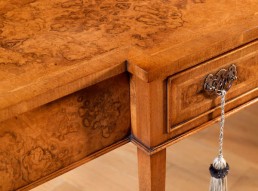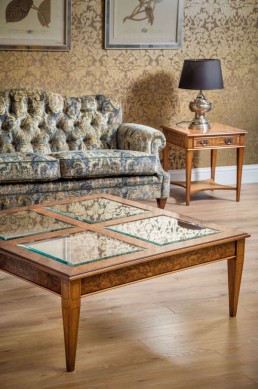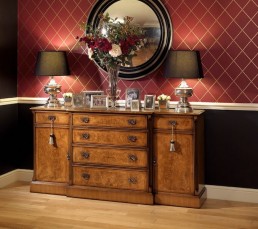Our Finish & Finishing Lines
All of our products are finished using time honoured traditional hand polishing methods which create a fine patina and depth of colour and can take as long as a week to polish.The furniture is often bleached to help achieve a lighter, softer shade often associated with antiques, before being hand coloured, shaded, distressed and polished. These processes involve splashes and scratch marks designed to enhance the final finish. Unless otherwise instructed, the product finish exhibits antiquing and distressing techniques.The process is completed by carefully dulling the finish using 0000 wire wool before being waxed.Finishing lines, which are visible in critical light, are testament to the hand application work undertaken during the many stages of polishing, as opposed to ‘off the gun’ finishes, and are not in any way a finishing defect. Waxing and natural oxidization will reduce thesefeatures over time.The finish of our products may feature small knots, marks and cracks which are natural characteristics of wood.


Understanding Timber
Our construction is a mixture of solid wood and veneers where applicable.Due to the natural properties of wood, expansion, shrinkage or movement may occur at any time.It's important to realise that although the timber is no longer part of the tree, it is always trying to return to its natural shape,Similarly, the way the wood would respond to humid and dry environments externally is also relevant to the modern-day internal surroundings.Central heating, in particular, reduces the moisture levelsin the atmosphere and may encourage join or veneer movement as may other fluctuations in temperature.Certain decorative hardwood timbers when laid as veneers can exhibit natural movement which may become apparent in the future, for which no responsibility can be accepted.Iain James can offer a restoration service to help remedy any such movement, however, the non-return of movement cannot be guaranteed.
Caring for your furniture
Frequently dust your furniture with a dry, soft duster and occasionally wax using a high-quality beeswax-based polish; twice a year is usually plenty, depending on how much wear the piece gets.Waxing will nourish the wood and help to prevent the surface of the wood from drying.During application, the wax should be applied to a manageable sized area and the excess quickly wiped off with a clean cloth.Whilst removing the excess wax, it is important that the cloth in use is clean so that the excess is not dragged around the surface and leaving streaks.As a tip, keep folding the cloth over or use an additional clean cloth to help achieve this.The wax should always be removed in the same direction as the original polish was applied. This can be seen by looking closely at the patina where fine finishing lines will display the direction of application.If applying Harrells or Liberon wax, which we use, please ignore the instructions to leave the wax to dry, otherwise it will be difficult to remove.Avoid using any spray polishes containing silicone which can wear through the patina.Any spillage should be immediately removed with a damp cloth and subsequently dried.Avoid placing hot objects on to the furniture as they may mark the finish.Try to avoid keeping furniture in strong sunlight, as this can affect the colour of the piece.


Environmental Care
Iain James is respectful of its environmental responsibilities and is one of the founder members of Woodland Heritage, an organisation with the long term sustainment of woodlands and forests within the United Kingdom at the forefront of its interests.Woodland Heritage is recognised as a unique initiative, which truly unites all tree lovers – a vehicle for wood users (and consumers) to “put something back” and contribute to the proper management of British Trees. Woodlands are capable of growing high quality timber whilst providing an environment that supports wildlife, but only if properly and continuously managed. Woodland Heritage will seek to help through funding projects, travel bursaries, research, education, spreading the word and co-operating with like-minded initiatives.Timber materials are also purchased from suppliers that source from legal and sustainable managed forests and comply with EUTR Timber regulations.